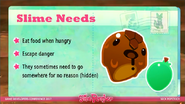Honey Slimes are slimes that reside in The Moss Blanket.
Slimepedia Entry
Slimeology:
Honey slimes are an odd breed of slime composed of a hyper-sweet slime compound. Most slime scientists believe this to be the result of their slime cells replicating the natural sugars found in the fruits and floral nectars of the Far, Far Range. Most ranchers agree their plorts taste great on cereal.
Rancher Risks:
The greatest danger a honey slime possesses is found in their plorts. Honey plorts are by far the sweetest, most delicious plorts known on the Far, Far Range. Other slimes can detect them from much further away than a normal plort and will do everything in their means to get it, so it is recommended to keep them away from other slimes. A rancher with honey slimes needs to be careful about unintended largos, or worse...
Plortonomics:
Honey plorts are highly prized by food manufacturers. Though the plorts are naturally incredibly sweet, the discovery that they could be refined into an even sweeter substance made their demand soar. These refined honey plorts are said to score an unprecedented 867 on the Werner-Thompkins-Hong sacchrino scale, just a few points shy of 'not fit for human consumption'.
Tips
- Slimes are attracted to Honey Plorts from further distances than normal Plorts, so it is recommended that Honey Slimes, as well as any neighboring corraled Slimes, have the High Wall and Air Net upgrades to reduce the risk of any slimes escaping into each other's corrals.
- Be especially wary of Tabbies, Hunters, and Saber Largos, since they can jump higher than normal slimes.
- Also, be sure to make sure there are no uncorralled Slimes loose around them.
- Honey Slimes seem to get hungry less often than other Slimes.[citation needed]
Changes
- 0.6.0 - Honey Plorts are now detected from further away. Before, this didn't really happen.
- Before 0.2.0 - Implemented.
Trivia
- Honey Slimes are based on real-world honey. The hexagonal shapes on their foreheads reference the honeycombs that bees store honey in, after consuming nectar to convert it into a syrup via enzymes, and then regurgitating it into a honeycomb. Once all the moisture has evaporated from the syrup, they seal up the honeycomb with wax.
- Their diet of fruit references the connection between bees' collection of nectar, which in turn pollinates flowers required to develop into fruits, and the conversion of nectar into honey. The mango is one such plant that requires pollination.




